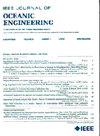基于物联网和LoRa的海洋监测的TRITON-Open遥测和位置估计
IF 3.8
2区 工程技术
Q1 ENGINEERING, CIVIL
引用次数: 0
摘要
生物学和生物遥测是更好地了解海洋物种的重要工具,从而有助于增加我们对整个海洋生态系统的了解。传统上,评估海洋巨型动物的轨迹成本和劳动力都非常高,而且无法保证设备的回收,而快速地理参考技术仍然是专有的,而且耗电量很大。物联网(IoT)和开放无线电通信协议,如远程(LoRa),为创建强大且低成本的传感器网络提供了机会,但仍需要在恶劣的海洋环境和海洋物种中进行进一步测试。本研究着眼于将LoRa和IoT应用于海洋物种的现实生活,提供了四倍的贡献。首先,我们回顾了当前的生物遥测和生物学,概述了机会。其次,我们提出了TRITON,一种用于海洋巨型动物监测的开放式遥测传感器。第三,提出了一种基于辅助GPS和简化伪距多乘的定位估计方法。第四,我们通过模拟海洋物种行为的四项野外研究验证了位置估计管道,使用七颗卫星获得了$\text{500}\;\text{m}$大平均误差。我们讨论了如何利用TRITON系统进行长期和短期海洋巨型动物监测,为更多的LoRa和物联网生物遥测应用铺平道路。本文章由计算机程序翻译,如有差异,请以英文原文为准。
TRITON—Open Telemetry and Location Estimation for Marine Monitoring Based on IoT and LoRa
Biologging and biotelemetry are essential tools to better understand marine species and consequently contribute to increasing our knowledge of marine ecosystems as a whole. Assessing marine megafauna trajectories is traditionally performed with significantly high cost and labor, without guaranteeing the equipment recapture, where quick georeferencing techniques remain proprietary and power intensive. The Internet of Things (IoT) and open radio communication protocols, such as long range (LoRa), provide opportunities for the creation of robust and low-cost sensor networks, which still need to be further tested in the harsh oceanic environment and on marine species. With a vision on having their real-life application on marine species, this study provides a fourfold contribution with LoRa and IoT. First, we review current biotelemetry and biologging, outlining opportunities. Second, we present TRITON, an open telemetry sensor for marine megafauna monitoring. Third, we provide a novel location estimation pipeline based on assisted GPS and simplified pseudorange multilateration using raw satellite data. Fourth, we validate the location estimation pipeline with four in-the-wild studies, mimicking the behavior of marine species, obtaining $\text{500}\;\text{m}$
求助全文
通过发布文献求助,成功后即可免费获取论文全文。
去求助
来源期刊

IEEE Journal of Oceanic Engineering
工程技术-工程:大洋
CiteScore
9.60
自引率
12.20%
发文量
86
审稿时长
12 months
期刊介绍:
The IEEE Journal of Oceanic Engineering (ISSN 0364-9059) is the online-only quarterly publication of the IEEE Oceanic Engineering Society (IEEE OES). The scope of the Journal is the field of interest of the IEEE OES, which encompasses all aspects of science, engineering, and technology that address research, development, and operations pertaining to all bodies of water. This includes the creation of new capabilities and technologies from concept design through prototypes, testing, and operational systems to sense, explore, understand, develop, use, and responsibly manage natural resources.
 求助内容:
求助内容: 应助结果提醒方式:
应助结果提醒方式:


